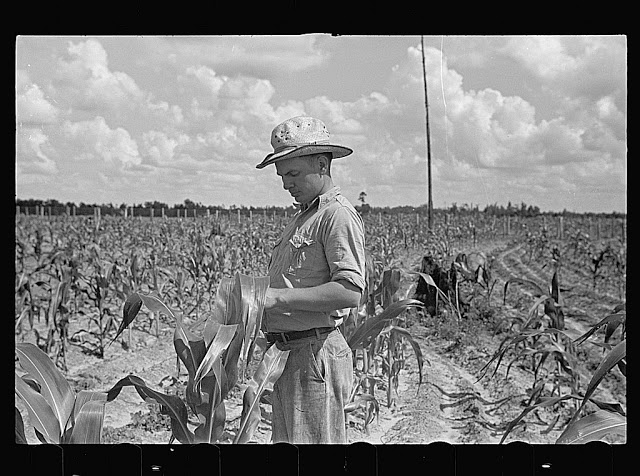Gardening without irrigation? Are you mad?
No.. I don’t think so. Though you may not be able to garden completely without irrigation, I do believe you can lower your garden water usage considerably by changing your methods.
The key to getting more out of your garden while watering less seems to be adding extra space for each plant’s root system. We live in the Age Of The Raised Bed, so this sound nuts… but there are solid reasons to grow in rows with wide spacings.
Check out what Steve Solomon, author of Gardening When It Counts, has to say:
As recently as the 1930s, most American country folk still did not have running water. With water being hand-pumped and carried in buckets, and precious, their vegetable gardens had to be grown with a minimum
of irrigation. In the otherwise well-watered East, one could routinely expect several consecutive weeks every summer without rain. In some drought years a hot, rainless month or longer could go by. So vegetable varieties were bred to grow through dry spells without loss, and traditional American vegetable gardens were designed to help them do so.
I began gardening in the early 1970s, just as the raised-bed method was being popularized. The latest books and magazine articles all agreed that raising vegetables in widely separated single rows was a
foolish imitation of commercial farming, that commercial vegetables were arranged that way for ease of mechanical cultivation. Closely planted raised beds requiring hand cultivation were alleged to be far more productive and far more efficient users of irrigation because water wasn’t evaporating from bare soil.
I think this is more likely to be the truth: Old-fashioned gardens used low plant densities to survive inevitable spells of rainlessness. Looked at this way, widely separated vegetables in widely separated rows may be considered the more efficient users of water because they consume soil
moisture that nature freely puts there. Only after, and if, these reserves are significantly depleted does the gardener have to irrigate. The end result is surprisingly more abundant than a modern gardener educated on intensive, raised-bed propaganda would think (read the rest)
Until I did more research, I had always assumed the wide row spacing of traditional gardens had more to do with the need for using tractors and mechanized equipment than anything else. Apparently, I was wrong.

Check out the wide row spacing. Original image here.
This spring, to test the idea that plants need much less water when spaced further apart, I planted a big patch of corn at 6″ spacing in 3′ rows. I haven’t watered it (except for the liquid fertilizer mix I poured along the roots every week or two) and it’s doing excellently thus far on nothing but rain. I also planted bush beans spaced 6″ apart in rows spaced 18″ wide. Though they’re not as happy as the corn, only some have kicked off.
I’ll keep you all posted on my results. I’m going to do further tests on gardening without irrigation, since one of the biggest drawbacks of modern gardening is the time it takes to water, not to mention the water itself.
Check out his book Water-Wise Gardening here.


8 comments
It would make sense to say that the densely planted crops would have much less surface area to draw moisture from. Since most annuals are shallow rooted, they were planted in rows in home gardens to allow for lateral if not longitudinal root expansion.
I find the hot winds to be much more devastating than the rainless heat. If anything, more densely planted areas would shelter more wind. Then plants on the edges would become more stressed, probably succumbing to pests hopefully after providing pollen for your sheltered crops. Keep us updated!
The winds strip away moisture like mad. Planning to block those is a really good idea. There are bamboo windbreaks on two sides and a hedge on the other side of where I'm now growing my test patches. I'm sure it helps.
I'm sure it does help.
In my experience, raised beds work very well in clay soil. With lots of mulch to hold in the moisture…. On top of the beds, and in the paths… Clay soil holds moisture very well…
In the sand… A raised bed is nuts… I see people doing it in sand, but I don't know why!
Good job experimenting, but this year is anything but typical of our normal rainfall… And except for the increased rodents, any kind of planting would be successful.
I'm familiar with the typical rainfall patterns. Interestingly, the field where I'm doing my widely spaced crops is usually worked by a local farmer who grows watermelons, corn, beans, etc. without irrigation. His spacings are 3'.
As for raised beds, yeah. Great on clay.
I think sunken beds are probably better for sand, if not for your back…
Very interesting. On our tropical island, where we get plenty rain, we probably don't have to think about spacing for watering, but it sure helps in reducing pests and plant mildew.
Wide spacing would result in lots of non-shaded soil and millions of weeds … unless you mulch like crazy. If you do mulch – sounds like a good idea. Or may be an appropriate cover crop – sure, it'll use some water but many of them will pay back with fertilizer, shade, etc.
Yes, the weeds pop up. However, I now have a wheel hoe. That's an amazing tool – cleaning up the rows can be done in minutes.
Mulching can be great, but on the size plots I'm making, it won't work. There's just not a good source – plus, when weeds come through mulch, hoeing is a pain.
It's not permaculture farming, but big plots with wide spacing is certainly a good way to make a lot of food. I'm really hoping to get a full year's worth of chicken feed growing this coming fall.
Comments are closed.